
The Mid-Valley SPIN
Newsletter of the Mid-Valley Bicycle Club
February 2022 MVBC Spin
Table of Contents
- From The President
- Bike education returns to area schools for 2022
- Free Legal Clinic
- What's in your ear?
- Pop-up bike shop
- Club Insurance: coverage and e-bikes
- In Memory ...
- Insert(s) your new favorite tire accessory here ...
- Garmin Radar review
- Touring with Nancy
- Klickatat Rail Trail
- Coast Range Gravel Adventures
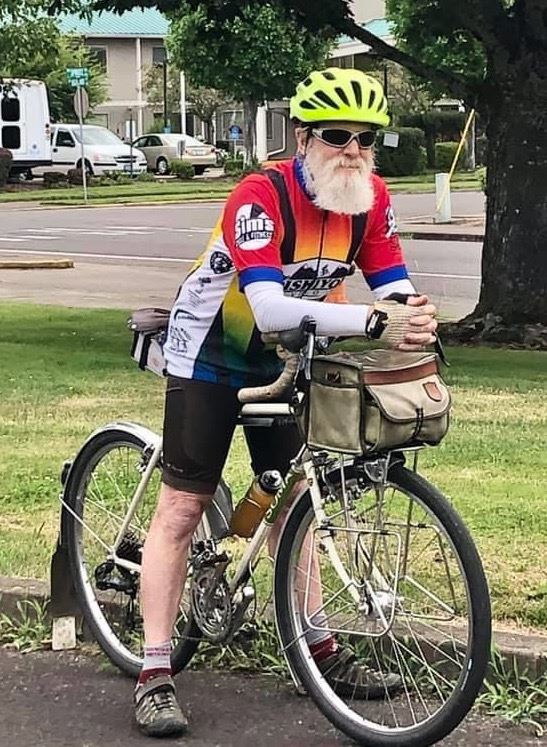
From the President
Paul Lieberman
Like many club members I like to use my bike for basic transportation as much as possible. That's pretty typical here in Corvallis. There is quite a culture based on using a bicycle for everyday commuting, and just getting around. Unfortunately a lot of these people aren't MVBC members. If you asked them why the typical response would be "Oh, I'm not really a cyclist, I just ride my bike around town." I might then try to tell them that the bike club advocates for safer streets and that many of our members have used their bikes for commuting for years. Still the image persists that the bike club is only for people who want to put on their lycra kits and go out in big groups and ride long distances at a fast pace. I wonder how we can overcome that impression and let people know that the bike club is for everyone who rides a bike, or has kids that ride bike, for whatever purpose? One thing we can do is to talk to people we meet when we're out and about and let them know about our advocacy work and involvement with bike education and safety. I guess that means we're all ambassadors for the club. I'm sure most of the people who commute by bike would have attended our January general meeting had they known about it. How do we do a better job at getting the word out? My goal is that everyone I see out on bikes feels like they have a reason to join the bike club, and that the club is engaged with things that interest and benefit them.
Coming Soon ...
A quick look at upcoming events. For a full list, check the calendar at https://www.mvbc.com/calendar for tour dates, club and area bicycling events.
June 19-26 Loop Tour #1
July 16-24 Loop Tour #2
August 14 Covered Bridge Bicycle Tour
September 30-Oct 3 Coast Range Gravel Adventure
Club News
Bike education returns to area schools for 2022
Big thanks to volunteers, success of CBBT
After a covid-year-off impacted bike outreach, MVBC’s bike education is returning for 2022. The bike education and helmet programs are both funded with the proceeds from the Covered Bridge Tour, MVBC’s biggest fundraiser.
Nancy Meitle has been key to organizing and coordinating the bike education program for the area schools and the helmet distribution program and she is looking for volunteers for this spring’s bike education program. The program can use 5-6 volunteers each day. If interested in helping, please contact Nancy at 541-753-0304 or email her at meitle@comcast.net.
Albany Schools
Albany did not have a bike education program in the fall of 2021 but hope to do a full course in the spring of 2022.
“We missed two full years of bike safety in Albany, so we are anxious to get as many kids through the program this spring as possible. Unfortunately, we will have less playground space and we may also have fewer days and shorter classes than we have had in the past. We need fully vaccinated volunteers to make this work,” Nancy said.
“They want to hit the ground running and we’re hoping to get as many kids through as possible,” Nancy explains. “Biking makes kids feel good and that’s something they need right now for safety measures and mental health.”
Because they are hoping to instruct two classrooms of 5th grade students each week from April to June (about 10 weeks) the need for volunteers has increased. In the past, groups of volunteers from Corvallis have made an event of volunteering: they have ridden to Albany to help with the kids, gone out for lunch during the break in classes and then returned for the afternoon session.
In Albany, there is also a paid position of bike instructor through the school district. Previously, this role was filled by a graduate student but she was unavailable for this year. The instructor needs to be available for 10 weeks, Monday through Friday for about six hours each day. The exact times will be dictated by the classroom schedule.
Corvallis Schools
In Corvallis, they did instruct a fall program in 2021 but with no volunteers. All instruction for 5th graders was done in house by teachers, aids and one paid staff member. The program was a slightly shorter version than what is typically offered. This year's plans for 2022 Corvallis 5th graders will return to using community volunteers. The biggest need is on Fridays. Please contact Reed Lacy for more information: reedlacy6@gmail.com.
Currently, MVBC works in partnership with the Corvallis, Albany and Lebanon school districts to provide the bicycles and other equipment needed to introduce elementary and middle school kids to cycling and safety.
MVBC provides funding for a complete set up for each school district: bikes, helmets and an enclosed trailer for storing the bikes. The surge of interest in biking during covid has had an unfortunate effect on the supply chain and a new fleet of bikes for the schools program has been delayed: 40 bikes have been ordered but the delivery date and pricing are unknown at this point. MVBC and the partner schools are actively seeking creative solutions.
A new middle school bike program in Corvallis won’t start this year but they are targeting fall of 2022.
“The first year of the Corvallis middle school program will target the kids who missed Bike Safety in 5th grade because of Covid. The long term goal is to reinforce bike safety skills learned in 5th grade and teach bicycling for both fitness and recreation. The middle school program may also become a feeder program for the Mountain Bike Team,” Nancy said.
Even though 2020 and 2021 were challenging, there were still events where MVBC was able to help the community, including a big push at the start of the school year. Nancy said that this year, the focus was on providing helmets free to those most in need versus the typical helmet by donation program.
“There was still a lot of good stuff we’ve been able to sneak in, safely,” said Nancy. “It’s always fun when you put a helmet on a kid's head and they smile at you. The kids are so excited and appreciative. There are kids who couldn’t ride on Monday and by Friday they were able to ride five miles.”
In addition to the program in the schools, membership director Eileen Tokuda has been working on setting up a popup shop to help relieve the surplus of children's bikes at the bike collective. Volunteers are working to refurbish the bikes. There will be an event in spring to help distribute through Vina Moses. (see related article)
If interested in helping, please contact Nancy at 541-753-0304 or email her at meitle@comcast.net.
club News |
Pop-Up Bike Shop
Corvallis Bicycle Collective, MVBC join forces for April bike event
Pop-up shops are springboards for introducing more people to active transportation and show how bicycling can be incorporated into their everyday lives to make it a healthy habit. The goal is also to improve access and inclusion in bicycling so kids and families have opportunities to ride for transportation, exercise and for fun.
The pop-up shop will be in April 2022 (date TBA). MVBC volunteers and CBC volunteers have a goal of preparing a minimum of 50 children bicycles that are serviceable and fully operational. MVBC volunteers are working on this now through March. MVBC 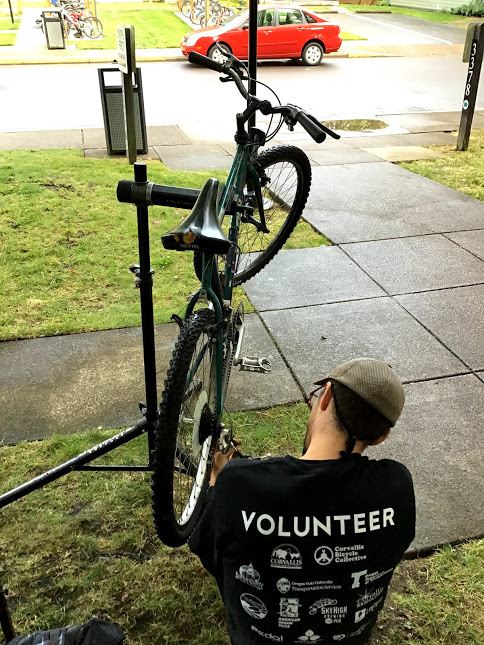 mechanics, Bruce Martin, Mark Gire, Eric Cardell and Steve Kadas are prepping 40 bicycles.
mechanics, Bruce Martin, Mark Gire, Eric Cardell and Steve Kadas are prepping 40 bicycles.
MVBC will be providing the helmets and volunteers to staff a helmet fitting station. As always, the helmets and fittings will be available at no cost/donation basis only to people who get a bike, courtesy of Mid Valley Bicycle Club. Nancy Meitle is the leader of the helmet program (see related article).
Teddi Crotti and Randye Jensen will be helping with translation. We are still seeking an Arabic translator.
In previous years, Corvallis Bicycle Collective partnered with Benton County School Health Navigators to host temporary, pop-up bike shops at local Title One, dual immersion schools in underserved neighborhoods. Children and families who work with School Health Navigators (see below) were chosen as our target audience: participants either qualified for free or reduced lunch, were Spanish or Arabic speakers, or both. Anyone was welcome to participate in the Pop-Up Bike Shops, but bicycles were not available to the general public. Donated bicycles fixed-up by CBC were at the pop-up shops and everyone who received a bicycle also received a new helmet and a bike light. Mechanic services were also available at our Ask-a-Wrench mobile repair station. CBC hosted two bike drives prior to the pop-up shops.
The Pop-Up Bike Shops were at Lincoln Elementary and Garfield Elementary School.
On event day, volunteers helped participants fit bicycles and helmets. Volunteers also helped children learn to ride a bicycle independently.
If you would like to help volunteer at the Pop-Up Bike event, please contact Eileen Tokuda at membership@mvbc.com.
History of School Health Navigators
In 2013, five focus areas and four guiding principles were identified in the Benton County Health Improvement Plan to improve community health and resiliency. CHIP goals and objectives reflect a systems change approach to meeting the diverse needs of Benton County residents. CHIP calls for “establishing community health workers in neighborhoods and schools to improve access to health services, improve health knowledge and behaviors, and navigate complex health and social service systems.”
Securing IHN/CCO pilot project grant funding, the Health Navigator program started as a partnership between Benton County Health Department and Corvallis School District. Two Navigators were placed directly in two local schools the first year, with a third Navigator and school added the second year of the grant.
School Health Navigators work directly with children and families at Title 1 schools. Title 1 schools are identified by the State of Oregon as schools with high numbers or high percentages of low income children attending that school. School Health Navigators connect children and families to services that meet families’ everyday, emergent, crisis, or other health-related needs. They are bilingual Spanish-English speakers, lead regular community meetings in the neighborhoods where their clients live, and act as advocates in health care, social service, recreational, and community-building settings. These permanent positions are currently funded through a cooperative model between Benton County Health Department and Corvallis School District. School Health Navigators make schools a focal point - as identified in BCHIP - and build partnerships in the community to meet the needs of the whole person.
Health navigators are placed in schools to coordinate with students, parents and teachers regarding students’ health records in order to boost access to health resources and services available through state Medicaid, as well as other school and community resources.
Club Insurance: coverage and e-bikes
A valuable member benefit!
Did you know that while you are participating in club activities you are covered by the club’s insurance?
Your MVBC membership includes insurance coverage provided through the League of American Bicyclists while participating in all paved and gravel bicycling related activities conducted and supervised by the club. This includes club rides, club meetings, and events.
What does this actually 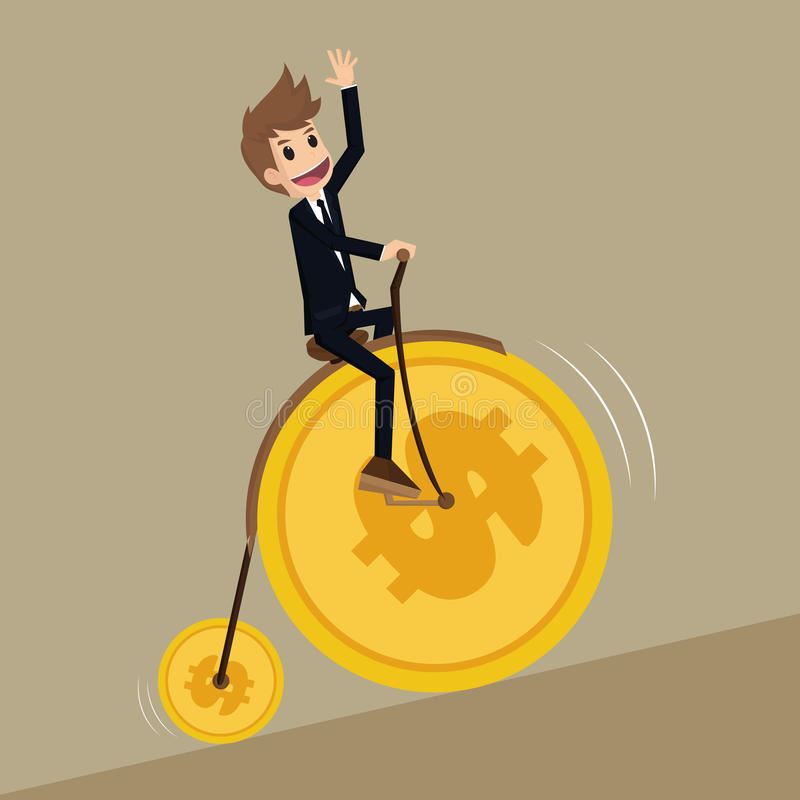 mean?
mean?
In order to be considered a club ride, a few criteria must be met:
- A ride leader must be assigned to the ride.
- Ride must be listed on ride calendar with start time and location
- Members must sign a waiver once a year (when joining the club and on annual renewal)
- If a breakaway sub group chooses a different route, a sub leader must be assigned to that group.
- Coverage begins at the official start point of the ride, or where a rider joins the ride along a route. Coverage ends when a rider leaves the group. First time guests on club rides are covered if they have signed a Waiver of Liability.
The following are not covered by Club insurance:
- Informal rides, organized through lists or email, because they are not conducted and supervised by the club.
- Members or Guests riding Class 2 electric bicycles equipped with a motor that may be used exclusively to propel the bicycle are not covered by club insurance. (see more on e-bikes below).
There are two types of coverage:
General Liability:
Protects members from liability claims against them for bodily injury, property damage and personal injury. Claims examples: A member cyclist strikes a pedestrian on a trail, or damages a car or other property
Limits: $1,000,000 per occurrence with a general aggregate limit of $5,000,000.
Participant Accident:
- Provides medical coverage to members and first time guests in case of personal injury.
- Accident Medical Coverage: $10,000 per person per accident with a $500 deductible. Coverage is secondary to claimant’s primary medical insurance
- Accidental Death and Dismemberment: $5,000 per person per accident.
What about e-bikes?
From the League of American Bicyclists:
There has been some confusion about how the League’s liability insurance program applies to the use of electric bicycles during club activities. The purpose of this correspondence is to clarify the intent of the liability policy. It is important to note that coverage for electric bicycles for club activities

has not changed from prior years and is consistent with what we believe to be industry standards.
For the purposes of this communication, the definition of electric bicycle is consistent with the CPSC definition and the League’s position on electric bicycles:
Class 1 electric bicycle shall mean an electric bicycle equipped with a motor that provides assistance only when the rider is pedaling, and that ceases to provide assistance when the bicycle reaches the speed of 20 miles per hour.
Class 2 electric bicycle shall mean an electric bicycle equipped with a motor that may be used exclusively to propel the bicycle and that is not capable of providing assistance when the bicycle reaches the speed of 20 miles per hour.
Class 3 electric bicycle shall mean an electric bicycle equipped with a motor that provides assistance only when the rider is pedaling, and that ceases to provide assistance when the bicycle reaches the speed of 28 miles per hour.
Based on the language from the insurance policy, losses arising from the use of a Class 2 electric bicycle would not be covered under the League’s club insurance program. Again, this is consistent with prior year’s coverage and our understanding of industry standards.
Questions, incident reports or claims should be directed to the MVBC Insurance Liaison: treasurer@mvbc.com
In Memory …
MVBC recently received a $100 donation from Barry A Hurff in memory of Bob and Marge Fry. The donation is to be used towards the children's bike education or helmet program. MVBC thanks you for honoring the club with your gift.
Jack Pinkerton was a long time club member who recently passed away. Jack left his collection of bikes and gear to the club. Four of his bikes were passed onto the Corvallis Bicycle Collective. MVBC kept a complete Bike Friday touring package including the travel suitcase, racks and panniers. The hope is to be able to have this available for members who want to try out a tour but aren't ready to invest in gear yet. We're still working on the details of how this program could work. We are sorry to hear of Jack's passing and very much appreciate him sharing his gear so that others can enjoy riding as much as he did.
Community Corner
Free Legal Clinic offered online
Your Legal Rights as a Person Walking or on Bicycle
by JoshCapps
Hello Active Transportation Supporter,
Know your rights and responsibilities when using the road as a cyclist or pedestrian. Thomas, Coon, Newton & Frost, a Portland, Oregon pers

onal injury law firm that has represented injured bicyclists and other vulnerable road users in legal cases since 1981, is offering a 1-hour online clinic sharing insights on Oregon laws, how to stay safe on the road, and what to do if you're in a crash. This clinic is hosted in partnership with Westside Transportation Alliance and The Street Trust.
All classes are free, open to the public and held over Zoom.
Registration is required to attend. Sign up through the links below.
Dates:Saturday 2/5 10:00am - Forest Grove City Library
Wednesday 2/9 5:30pm - Tualatin Public LibraryWednesday 3/9 12:00pm - Tigard Public Library
What’s in your ear?
Podcasts offer a great way to learn or be entertained while you’re driving, doing house chores or yard work. Hosts vary as much as the subjects but here’s some podcasts featuring outdoor and bike-related topics shared by MVBC member Lori Wilson. Most podcasts are available through a variety of listening apps. What are you listening to?
Adventure Cycling
Dynamo Jenny: A podcast about women, bikes, and taking up space in America
https://www.adventurecycling.org/subscribe/podcast/
Explore Oregon podcast from the Statesman’s Journal
https://www.statesmanjournal.com/outdoors/explore/
Here’s a few from Explore Oregon with a local flair:
Explore Oregon: Corvallis to the Sea trail
https://podcasts.apple.com/us/podcast/corvallis-to-the-sea-trail/id1434094360?i=1000532184637
Explore Oregon: New mountain bike trails at Silver Falls State Park form the Salem Area Trail Alliance (MVBCer Melissa Boyd’s sister Beth Dayton is featured!)
GEAR REVIEWS
Insert(s) your new favorite tire accessory here …
By David Lerman
Did you ever have someone in your life who made you better than you were almost effortlessly? For me that was my mother who repeatedly (yes, over and over and over) told me, “Everyone makes mistakes but not everyone learns from them.” With that simple intonement she simultaneously gave me permission to make mistakes and started me on a life-long search for the lessons, some simple, some complex, embedded in most mistakes.
Mom is gone now, but I continue to look for “opportunities.” I believe I have found an opportunity to make you and me better cyclists. Would you like to cycle faster, while not expending any more effort? Would you like to corner better in rough terrain? Would you like a smoother ride in deep gravel or challenging single-track routes? Would you like to make pinch flats a thing of the past? All of this is possible without the 6 million dollar investment necessary to make Lee Majors the bionic man (“We can make him better, stronger, faster.”)
I know it sounds too good to be true. But inserts can do all this and more. Inserts are dense foamy materials that live between the rim and tire of a gravel or mountain bike. Inserts are more useful the rougher your route. If you are a pure roadie, inserts are probably not for you. Different inserts are made for tubed and tubeless set ups. Some inserts are designed to be positioned between your tube and the tire, providing puncture protection as well. Others live next to the rim and mostly are there to protect the rim from damage with a heavy hit. Still others have an air pocket above and below. These are especially good at stabilizing the sidewall during turns.
First, let’s talk about faster, about 3% faster. Rolling resistance is energy expended to move your bike. Less rolling resistance means your bike moves forward with less effort. For uneven surfaces, rolling resistance increases with greater tire pressure. That’s because energy is wasted when your tire bounces off a root or rock. That bounce also sends a little shock wave up your bike to your arms, legs and butt. That shock wave makes for uncomfortable riding and can be dangerous if you lose your grip on the handlebars in a rough patch. Every gravel rider who has descended over washboard roads knows exactly how this works.
You can decrease the amount of bounce by reducing tire air pressure but then you risk not supporting the tire sidewalls on turns and rocks bashing into your rim through the tire. That can damage the rim and put a hole in your tire large enough that your sealant won’t plug it.
Inserts to the rescue! Even with lower pressures, your tire and rim are p
rotected by the layer of dense foamy material sandwiched between tire and rim. And your sidewall won’t collapse on a high energy turn because it is supported by that same insert. Even if you do flat, most inserts allow you to ride out without any air in your tire. You won’t be riding fast or far, but at least you won’t be walking!
Because you’re bouncing less, have more stable sidewalls and lower pressures, your tire has more contact with that rough terrain. That gives you more control at faster speeds and tight turns. Next time someone tells you to get a grip, your response might be to ask for an insert.
Like most things in life, inserts are not all good. They can cost up to $150 for a pair. That pain is lessened by insert durability. All of the manufacturers I contacted claim their inserts are good indefinitely. So unlike almost everything else on your bike from chains to brake pads to
tires, they won’t need to be replaced often or maybe ever.
Installation can be notoriously difficult. CushCore is the oldest and one of the better inserts on the market. Even the manufacturer states they are extremely difficult to install. Invite friends over to assist and be sure to have plenty of alcohol on hand. CushCore even makes a special “bead dropper” ($20) to assist, if the friends and alcohol are not enough. None of the other inserts advises anything extra beyond some soapy water.
I’m riding Tannus Armour inserts. I did employ some muscle getting them over the rim but not a big deal. They are less expensive than CushCore and in objective testing performed nearly as well.
Weight may be a concern for some riders. Inserts for mountain bikes weigh about 150 g. or 5 ½ oz. and about half that for gravel inserts. Weight varies greatly between inserts. If you multiply the average by 2 tires, you are adding about 11 oz. to your mountain bike. That’s not insignificant but wholly offset by the improvement in rolling resistance.
To get the full benefit of inserts you must decrease tire pressure. How much? As you might imagine, opinions vary on that. Most experts say a 2-5 PSI reduction is about right but that you should experiment. The actual number depends on what kind of terrain you cycle (rougher allows less pressure reduction), your tires (stiffer sidewall allows greater pressure reduction), the type of insert (see below) and how much you weigh (heavier riders need more air pressure).
Inserts are especially great for e-bikes. Because of their greater momentum, e-bike tires generally hit rocks and roots harder. All the more reason to protect your rims and dampen shock waves transmitted to your body.
Here’s a rough comparison of some of the inserts on the market (+ means better).
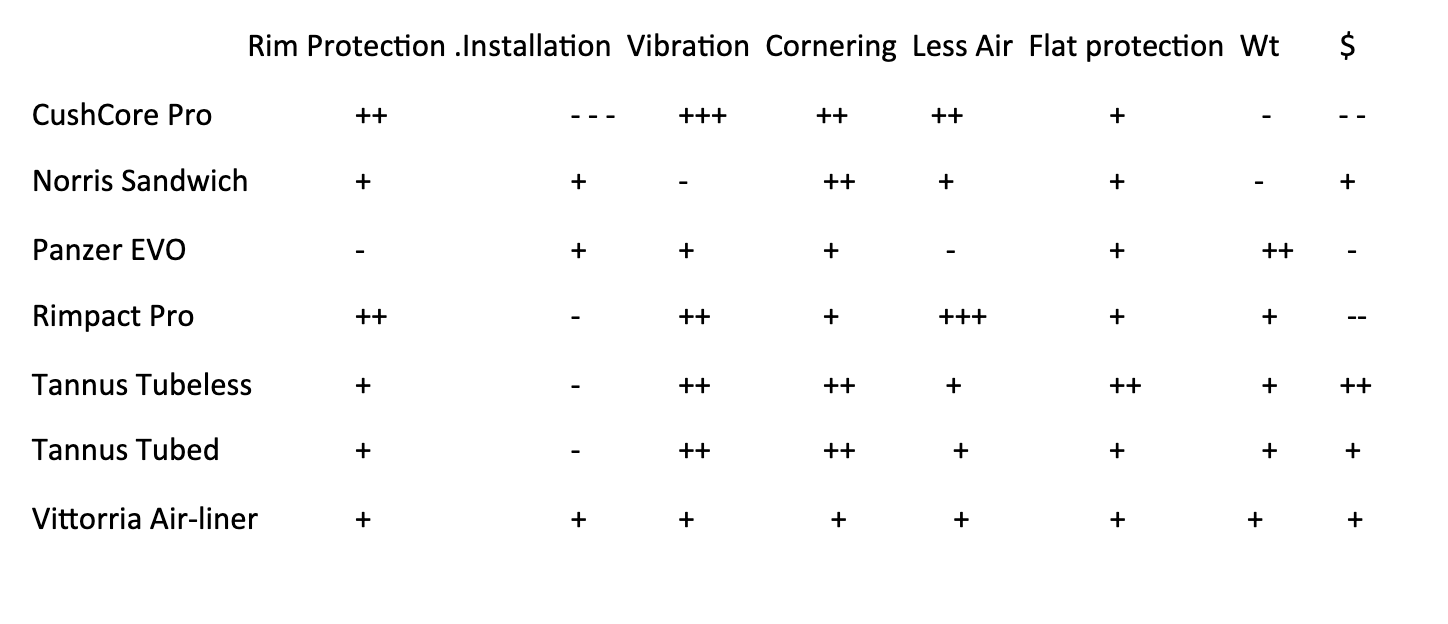
The problem with the table above is that no insert is great at everything. Each insert is probably best for at least one kind of rider and a given terrain. To select your insert, you will need to give some thought to what are the most important reasons you want an insert. For example, if your thing is bombing down steep descents full of rocks, you need the rim protection provided by Rimpact Pro and CushCore. If flat protection is high on your list and you are resisting tubeless, the Tannus insert might be your best choice.
Purchasing and installi
ng inserts can be a challenge. But after that, inserts are a pleasure. Depending on which insert you choose and how much air you take out of your tires, you should roll fast
er, grip rough terrain better, corner better and have fewer flats. Some riders feel the improvements are modest but most really enjoy the improved ride inserts can deliver.
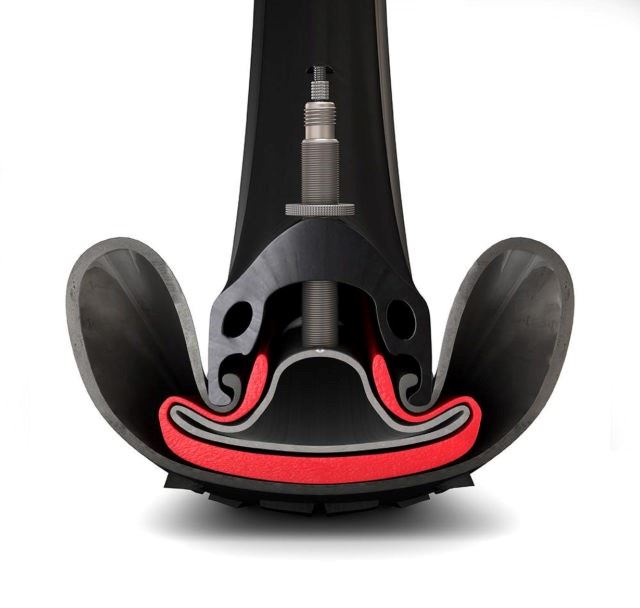
Tubed Tannus Armour on impact
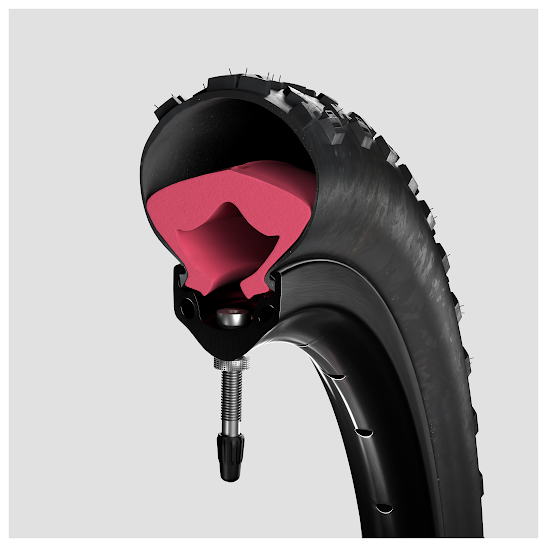

Tubed Tannus Armour Tubeless Tannus Armour
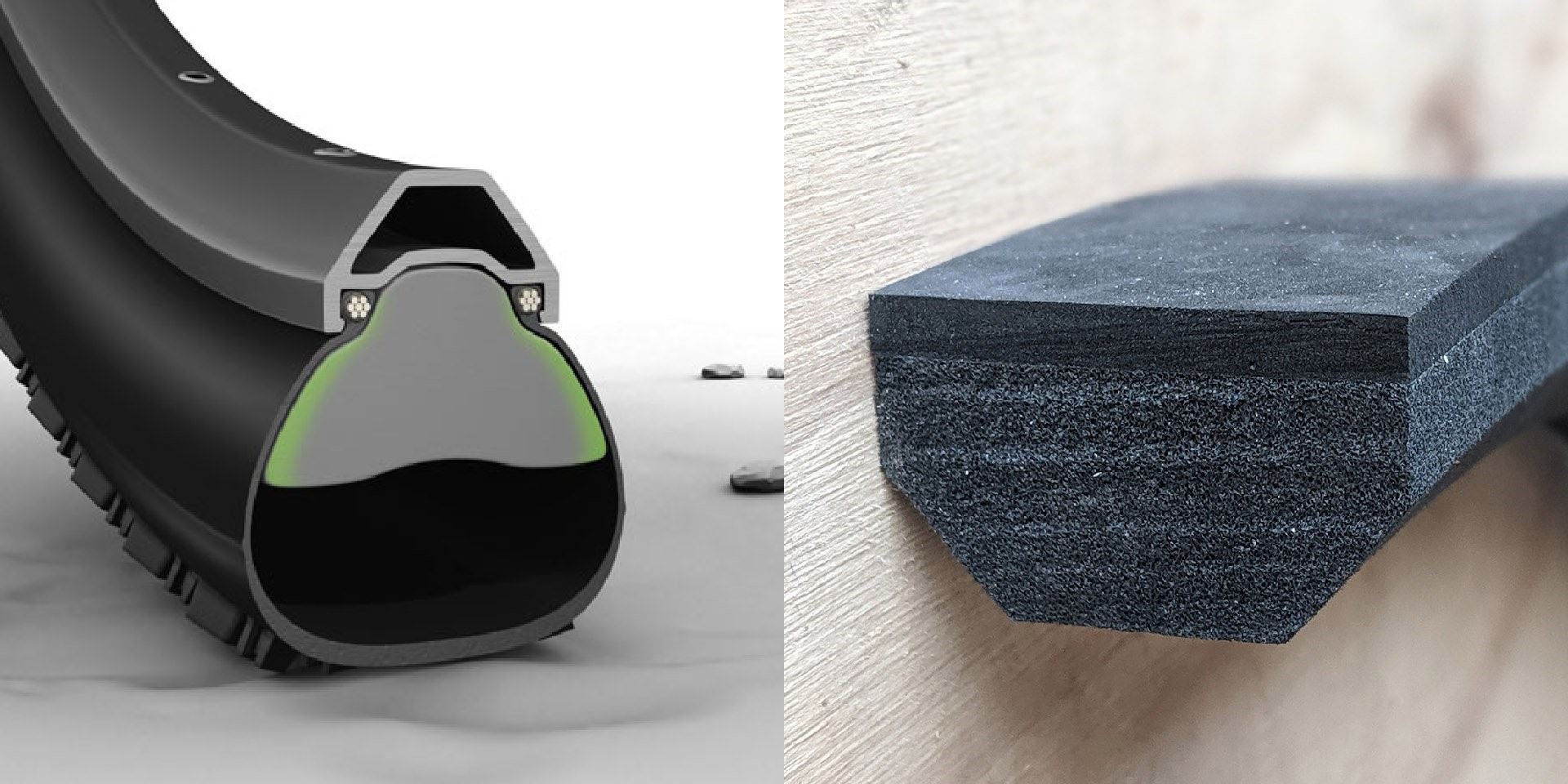
Cushcore Rimpact Pro
Review of the Garmin radar unit (RTL 515)
By Lloyd Swanson
Technology continues to advance our world, including with cycling. In about 2015, Garmin offered the world’s first cycling radar. Now, several versions later, this radar unit with the tail light integrated, alerts you when cars are coming.
I’ve been trying it out for a few months now and here’s what I’ve learned.
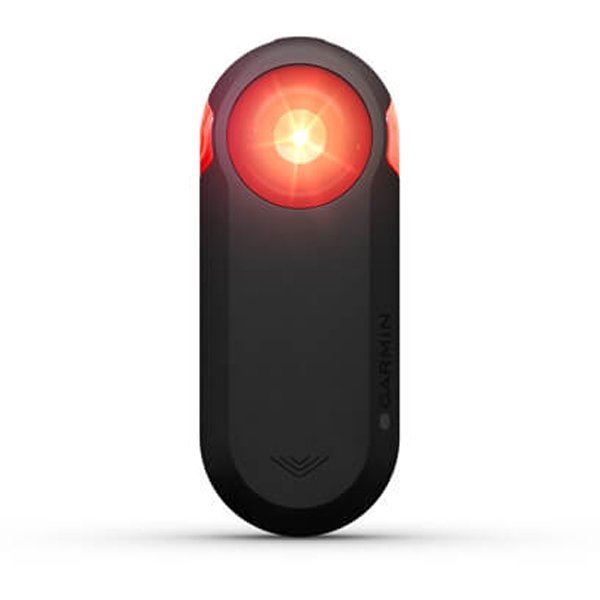
The unit is designed to be mounted on the seat post and should be vertical to the road. When paired with your bike computer, a smallicon appears in the upper right hand corner of your computer. It has a tail light with four different modes (solid, low level, night, day) that, when a vehicle is detected, begins to blink rapidly. The radar will detect any vehicle (including bikes) moving faster than you are. It will detect vehicles within 140 meters (460 feet) which sounds like a lot. However, a vehicle approaching you at 60 mph (88 feet per second) will be on you in 5.2 seconds. Not a lot of time but certainly enough time to move over. The unit has a rechargeable battery which lasts up to 16 hours. It works with your Garmin Edge bike computer (and a lot of other brands) or
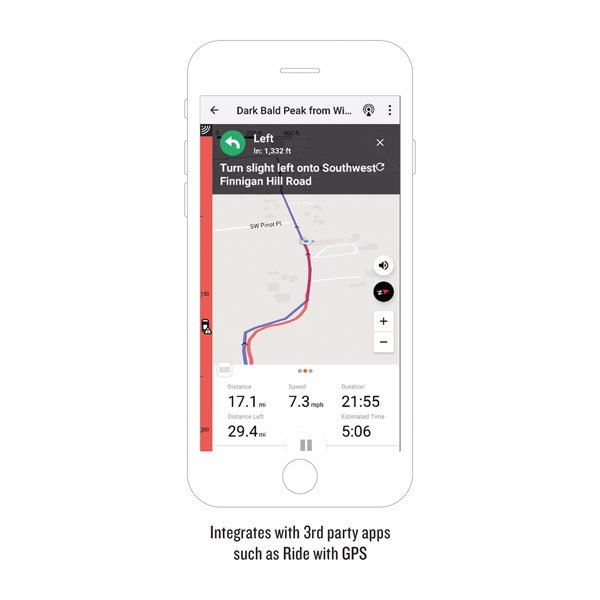
your smart phone. It costs $199.99 regardless of where you buy it. (A version without integrated tail light is about $50 less.)
The radar unit doesn’t tell you how close the vehicle will be to your bike. The law says they must give you 3-feet but not all drivers are so kind. When the radar detects a vehicle, it notifies you in two ways.
First, when a vehicle is detected, a red stripe appears on the outside vertical edges of your Garmin bike computer and a white dot(s) appears on the right (or left) side of the red stripe. How fast the dot moves to the top of your Garmin gives you a relative idea of how fast the vehicle is approaching. With multiple vehicles (up to 8) there will be multiple dots. When the last vehicle(s) has passed you the outside stripes turn to green for a few seconds and then nothing (all clear).
Second, your Garmin bike computer gives you an audible tone when a vehicle is approaching and a different audible tone when the last vehicle has passed. However, my hearing isn’t that good so I installed a Varia app on my phone which gives a louder audible tone via Bluetooth from the radar unit. When vehicles are passing me on a busy road, I don’t want to be looking at my computer for colors, dots, etc., but rather an audible tone.
I have found the radar to be very reliable at detecting vehicles. I don’t find it useful in town or a busy highway, like Hwy 99, when traffic is constant. Rather, I find it very useful on our backroads, like Green Valley, Bellfountain, Helmick, Kings Valley, etc. where it warns me of occasional vehicles which I may not hear.
I still find my mirror essential. When I get the audible tone I can look in my mirror and see how close the vehicle is (should I hit the ditch?).
There are a lot of videos on YouTube on installation, evaluation, etc.
The bottom line: I find the radar unit helpful; I like safety devices and this is one more mode of protection. I will keep it but I’ll also keep my mirror.
Others in the club also have the radar device and they are more enthusiastic than I.
Your mileage may vary.
Find out more at https://www.garmin.com/en-US/p/698001
Tour Reports
Touring with Nancy
By Tracy Hug
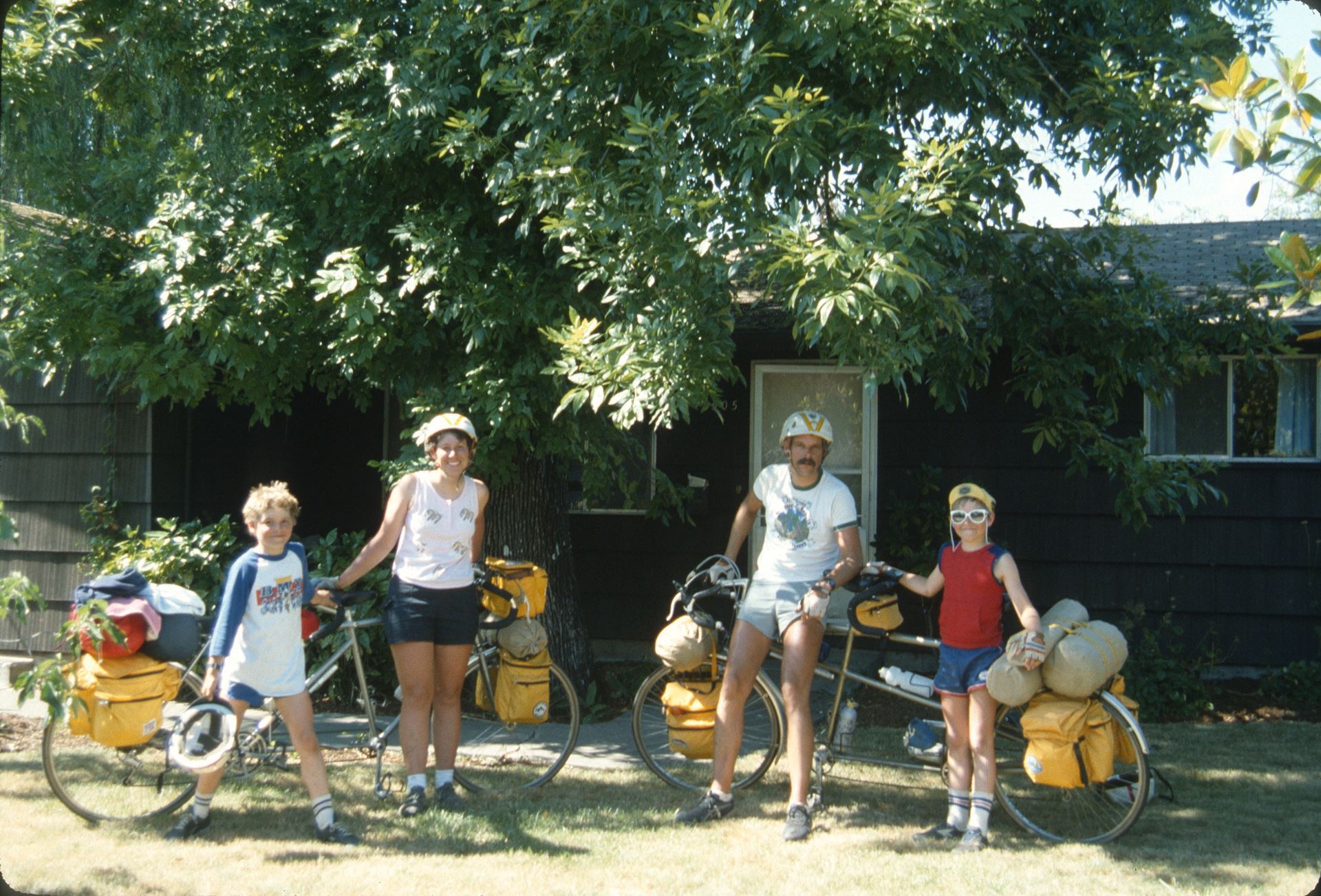
While many club members know that Nancy Meitle is key to the MVBC helmet program and also involved in the bike education for the schools, you may not know she has a wealth of MVBC history and years of experience touring.
Nancy joined the bike club in 1982. That year, she took part in the Great Alaska Bike Trek -- a 4,400-mile bicycle journey from Anchorage, AK, to Long Beach, CA, to benefit the Mental Health Association. Like any good bike tour, she came away with friends that last: 17 of the riders were on a Zoom recently and are preparing for the 40th anniversary of their ride!
Because her daughter grew up hearing stories of the Alaska trip, she wanted to experience it for herself. So when she turned 18, Nancy agreed to buy her a bike but only if she agreed she would make it at least to Whitehorse, Canada: 1,000 miles!
“I wasn’t going to buy her a $1000 bike if she was going to quit. The deal was she had to get to at least Whitehorse,” Nancy said. “ I was strong but she was young. By the time we got to Whitehorse, she was out ahead of me and would stop and read a book while she waited.”
She and her daughter finished the ride: They timed their time in Washington to coincide with the 25th reunion of the 1982 Great Alaska Bike Trek and were able to ride back from Vernonia to Corvallis with the MVBC loop tour that year. “We finished the tour with 40 good friends.” (Now that’s route planning!)
Nancy’s done numerous loop tours through the years but she recalls her first loop tour as her most memorable tour. Back in 1982 when she was riding from Alaska, her soon-to-be husband Chuck was biking in Europe for six weeks of the summer. Because they had been biking all summer, they were very strong and enjoyed riding together.
Their first loop tour was when she and Chuck became a couple. They teamed up with another pair of strong cyclists to become a cooking group on tour, creating lasting friendships.
“ It was me and three guys riding around the Wallowas together. Oh what fun!” Nancy said.
Through the years, Nancy and Chuck participated in many loop tours with their kids and their grandkids: “We had two kids, two tandems and did tours including loop tour. Once we had grandkids, we did it all over again!”
One year on loop, she remembers, there were more kids than adults.
“They had us outnumbered!” she said. “It was fun to watch these high school kids try to figure out how to cook meals on their own.” She notes that the club has always evolved with new riders coming in as others age out. Many of the “kids” that she rode with now have children of their own and some have moved away.
In addition to loop tours, Nancy, Chuck and their family went back to Alaska in 1992 for two weeks. After that trip, they went back to Alaska every year for 15 years. They rode from Anchorage to Fairbanks and spent time in Southeast Alaska “ferry hopping.” They would travel by ferry and then when they arrived in town, they would bike to local (or not so local!) campgrounds to set up their tent for their stay.
They were happy to share Alaska: they planned a MVBC loop tour to Alaska and rode at least three tours in Alaska with “Grand Jan” on the tandem.
“We took GrandJan when she was 78, 79 and 81. I remember being at the Mendenhall Glacier (a popular tourist attraction” and we were a tourist attraction. A tourist came over and asked Jan, ‘May I ask you a personal question: How old are you?’” Nancy remembers. “That person then went back and told the other tourists.”
(For those newer to the club, Grand Jan was a long-time club member who rode into her 70s and eventually on into her 80s finding a spot on the back of Nancy’s tandem when Parkinson’s made her unable to ride alone.)
Nancy and Chuck were up in Alaska most recently in 2019 in the Sitka area where they were camp hosts. The Sitka area has been very successful in building a mountain bike community in conjunction with the local hospital. They have more than 300 members and have been building trails and there is now a bicycle collective repair shop there to help support more riders.
Clearly working with kids is a passion for Nancy. Tiffany Bailey from the Corvallis Composite MTB team said, “Nancy has not formally ridden with our youth mountain bike team, but like with so many other things, she has worked her magic behind the scenes. She has a special knack for creating opportunities for the riders to build camaraderie and responsibility. For example, last year when schools closed, she hosted groups of riders outside to tune up a fleet of bikes. Nancy has also helped the bike team reach students who need extra support and may be at risk. She has recommended students who need financial assistance and a little extra support to get on the bike team. We are grateful for her advocacy for young people! Also, Nancy is a trusted advisor to the Corvallis Composite MTB team as we look ahead reaching more students. We value her experience with building partnerships to help the whole bike community- road, gravel dirt riders- thrive.”
For someone who gives so much to young riders, what does she get from riding? Nancy said with a laugh, “Calm, energized, cold, wet and miserable but doesn’t it feel good?”
Nancy coordinates events throughout the year, please contact her at Meitle@comcast.net, if you are interested in helping with the helmet program.
Klickatat Rail trail
A historic and scenic trail along the Gorge in Eastern Washington
The Klickatat Trail begins at the confluence of the Columbia and Klickatat Rivers at Lyle, WA, and offers riders scenic views, mill town and railroad history. The 31-mile unpaved (packed gravel) trail is open to non-motorized use.
In spring of 2019, a group of riders from MVBC spent a weekend on the Klickatat trail. They rode a variety of bikes: though the website recommends front suspension. https://www.klickitat-trail.org/biking-tips Suggested time to ride the trail is 3-5 hours.
MVBC Teddi Crotti said, “It was really beautiful riding along the Klickatat River. We saw some of the old train trestles too which were interesting. For me, it was a real adventure: I had never done any gravel riding before so this was a good introduction: some of it was pretty rough.”
The group from MVBC rode two days: one on the Klickatat Trail and one on the Deschutes River Trail. They spent two nights, some of the group camped and some got a hotel, the advantage of being near civilization.
The grade is gradual and gentle as it’s a former railway bed. The surface varies: and at times is “incredibly rough” (per the website.) It is 70% mixed rocks and dirt but with a clear route through, 15% is nice dirt, 10% is RR ballast, 5% is rolled gravel. The trail does not typically have “mud holes” unless it has rained recently.
The creation of the trail was not uncontested: there were opponents to the trail (in the early days) who at times expressed themselves by presenting their guns. MVBC member Bob Hansen was involved with the evolution of the trail and the struggle to keep the former railway lines accessible to the public. His account of the dedication it took is available at https://www.klickitat-trail.org/trail-history.
More photos from the MVBC ride are at: https://www.facebook.com/media/set/?set=oa.2620817581326441&type=3
Coast Range Gravel Adventures
Trip 1: sun, fun, rain and camaraderie
by Peter Hewitt
The Coast Range Gravel Adventure, CRGA, offered two group rides this year: beginning on Friday the 24th and Saturday the 25th of September. The four nights and three days included 155 miles and 11,200’ of climbing. (Spoiler: we in the first group would live but with shortcuts. The second group would not be so fortunate with the weather this weekend.)
Trip one: Led by the ever-cheerful and attentive Lori Wilson, our 11-strong group of seven women and four men rolled southwest out of town through Philomath, past a minor accident on Highway 20 and soon into the woods and on the “dirt” of Woods Creek Road. Gravel is such an unpleasant word, seemingly focused on the rocks, less on the lack of pavement, or the soil. My first riding companion was Eric Rehm, who rode a fat bike, or rather, a bike with remarkably wide tires. He was delighted for his “Pugsley,” his name for his steed, upon reaching the dirt, and he experienced riding even faster than he’d been going on the preceding pavement.
A flat tire, via nail, slowed the group down on this first ascent, yet spirits remained high. The weather was gorgeous and the optimism for a great trip was solid. A lunch was enjoyed, sitting on the road just shy of a road-spanning gate over 1000’ feet above highway 20. We mostly climbed either on our own or with maybe one other. I would occasionally go back down to check on people. I quickly learned that George was a fast climber who liked to take breaks, and that if I waited for him, I’d likely soon be alone, for he ascends faster than I do, considerably.
The group seemed amazed that I had raw onion in my lunch. It seems to me that raw onion has been a staple of sandwiches across the country all of my life. Did it matter that I lacked a knife at the moment and took bites with my teeth from the hand-held vegetable, to chase down the fresh bread and basil? Priorities. I need sustenance, and, besides, food tastes great outdoors. Though I’d wished I’d known about those fresh cherry tomatoes in the back of Rick Olson’s sag truck. Yum!
While waiting to regroup after a downhill, after about 35 minutes, George is not coming down to our waiting group, so I ride back up to seek him. I found him only a few turns up the road, two tire tracks in the deep forest, his tools spread across the proximal tire track, and he was working to get his rear wheel off of his big orange CoMotion bicycle. Minutes later, we’d replaced the flat tube, inflated the new one and then spent about 8 minutes getting the wheel re-installed. “Pick it up,” George would tell me, his enduring body laying sideways on the ground, alongside his bicycle, giving him access to the drop-outs and the axle. A 12” wrench in his hand, and with that, significant force was applied to both of the rather large nuts on either side of the wheel. “Let it down.” Many cycles. George was focused in a way that I’d not seen prior. He is accomplished.
This first of four days of riding would take us over some rather rough chunks of rock and then down into some single track switchbacks that bore no rocks, thankfully. My own bike had four panniers, yet the trail was not clawing to remove them - at least not on the singletrack. Camping was delightful, for about 3.5 hours, and then the noisy campers arrived, taking 30 minutes of loud engine noise and much vocal coaching to get their behemoth trailer into its spot, next to our biker-hiker site. Ignoring them over the next five hours became a challenge as they seemed eager to disregard every campground rule.
Day two also saw us start riding at 9:30 am, with a big climb up Hilltop after only one mile of riding. I loved this climb. For me, pavement means quiet, peaceful, and secure. We were together at its bottom, and at its top, but in the middle, we spread out into our individual ways.
The descent was on dirt, on which we would remain for a few hours. The adventure was on our terms, as external forces remained diminished enough to allow us a sense of control of our destiny. The return to pavement brought a return to each other as we regrouped near 2 pm, a fraction of an hour before arriving at the Alsea River’s northern edge, just a few miles from its mouth.
Day three revealed the motivating factor of a coffee/bakery shop for breakfast: the group got its earliest start of the four days, by far. Green Salmon Coffee Company enabled good taste and humor to be evident. The day’s climbs brought some wild roads, one so wild as to be too wild for this trip’s intentions, and those who dared enter soon dared turn back and leave it. (We’d made another mistake in navigation.)
The real route 3412, a number I’d heard mentioned two days prior, was found and its reputation became an experience. Blackberry bushes reached almost fully across the tire tracks, once drawing blood from a finger (which I’d not given). And our SAG driver, Rick, proved that he is still on the learning curve after rescuing Rhonda whose tires were giving up air fore and aft. But it was fortunate that Rick had to turn around and back-track, for in doing so, they came upon Rhonda’s lonely rear wheel, awaiting a rescue. It had fallen off, unbeknownst to the motorized pair.
Five of our 11 skipped this second climb of the day, enjoying going around the vertical on blacktop, with sparse traffic. Great to regroup at Salmonberry Campground and put air back into Rhonda’s reinstalled wheels, thank you Justin Wirth. Showers began near 6 pm, bringing a rather early end to the day.
The final day began with the last of the 13 hours alone in my 2-man tent, thinking about how to proceed with the day ahead, while outside, only raindrops could be heard. When I finally got myself up and out into it all, I saw George cast himself out of the campground, riding away alone. I’d not see him again on this trip. Tracy Hug had warned, back in our Beachside Campground, night two, that there could be some barn-smelling and self-preservation speed homeward today if and when the rain is upon us. I too experienced it, fought it, and enjoyed the sub-tarp community as the others dissembled their camps. Committing to return here tonight to support the arriving second group, I enrolled tarp-owner Betty to agree to leave the tarp here, in welcome for the intrepid riders. What a joy it is to ride, warm and together, homeward bound. Never mind the rest.
Coast Range Gravel Adventure #2
Teamwork with tarps, wind and rain
By Christi Raunig
It was a great trip. We all made it to the coast. I wish there had been more single track. I wish I'd stopped more to take pictures; but I didn't want to hold others up. The section along Mill Creek was particularly beautiful in places.
All was well until we hit 101 when the wind became a considerable factor. I seriously thought my glasses were going to get blown off of my face as I crossed the bridge into Waldport. Thankfully, we got camp set up before the rain set in. And then IT POURED!
The pictures say it all. Many thanks to Peter Wendel for setting us up with a great tarp to eat under. And more thanks to our SAG driver, Nancy Meitle, who in addition to being there for all of us, took my panniers on day two when we had the big four-mile hill to climb and then picked up Chinese for everyone who wanted it in Waldport. She also made a killer coffee cake that was a wonderful treat.
What would I do differently? Get another year of riding under my belt so that I can take my own panniers to the top of the hill. :)
Some riders from the second group were able to go back the next weekend to complete the ride! That’s dedication!
Here's a link to the Google Photos Album for coast gravel #2: https://photos.app.goo.gl/HWuNaKEzbkDxMpsn8
Upcoming events
- No upcoming events